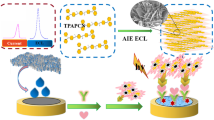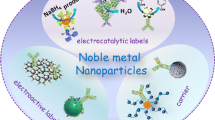Abstract
Ruthenium(II) complexes with carboxylic acid as a bioconjugatable group, i.e., [Ru(bathophenanthroline disulfonate)(2,2′-bipyridine)(4-methyl-4′-(3-carboxypropyl)-2,2′-bipyridine)]0, (C49H38N6O8S2Ru), and [Ru(bathophenanthroline disulfonate)2(4-methyl-4′-(3-carboxypropyl)-2,2′-bipyridine)]2− · 2Na+, (C63H44N6O14S4RuNa2) were characterized spectroscopically and electrochemically. As potential labels for electrochemiluminescence (ECL) immunoassays, the ECL intensities of the free labels in homogenous aqueous buffer solutions were compared under a condition that is similar to the one employed by a commercial clinical immunoassay system. The two labels were found to be more emissive and, thus, can be detected at 10- 12 pM compared with 5× 10−12 pM of the label currently used in the commercial ECL system. Furthermore, the improved ECL emission of the free labels in homogenous solutions was proven to be translated into more intense ECL signal in heterogeneous sandwich immunoassay and, thus, leading to a lower limit of detection in immunoassay. The data obtained from these ECL labels shed light on the further development of ECL-based clinical immunoassay technology.

Electrochemiluminescence immunoassays were carried out with three different ruthenium(II) complex labels. It was proved that the higher signal intensities found with the novel labels in homogeneous solutions were maintained in heterogeneous sandwich format.







Similar content being viewed by others
References
Kricka LJ. Clinical applications of chemiluminescence. Anal Chim Acta. 2003;500(1/2):279–86.
Zhao LX, Sun L, Chu XG. Chemiluminescence immunoassay. TracTrends Anal Chem. 2009;28(4):404–15.
Fan AP, Cao ZJ, Li HA, Kai M, Lu JZ. Chemiluminescence platforms in immunoassay and DNA analyses. Anal Sci. 2009;25(5):587–97.
Blackburn GF, Shah HP, Kenten JH, Leland J, Kamin RA, Link J. Electrochemiluminescence detection for development of immunoassays and DNA probe assays for clinical diagnostics. Clin Chem. 1991;37(9):1534–9.
Kenten JH, Casadei J, Link J, Lupold S, Willey J, Powell M. Rapid electrochemiluminescence assays of polymerase chain reaction products. Clin Chem. 1991;37(9):1626–32.
White HS, Bard AJ. Electrogenerated chemiluminescence. 41. Electrogenerated chemiluminescence and chemiluminescence of the Ru (2,2′-bpy)3 2+-S2O8 2− system in acetonitrile-water solutions. J Am Chem Soc. 1982;104(25):6891–5.
Bard AJ, editor. Electrogenerated Chemiluminescence. New York: Marcel Dekker Inc.; 2004.
Leland JK, Powell MJ. Electrogenerated chemiluminescence: an oxidative‐reduction type ECL reaction sequence using tripropyl amine. J Electrochem Soc. 1990;137(10):3127–31.
Deaver DR. A new nonisotopic detection system for immunoassays. Nature. 1995;377(6551):758–60.
Yang H, Leland JK, Yost D, Massey RJ. Electrochemiluminescence: a new diagnostic and research tool. Nat Biotechnol. 1994;12(2):193–4.
Miao WJ. Electrogenerated chemiluminescence and its biorelated applications. Chem Rev. 2008;108(7):2506–53.
Hu LZ, Xu GB. Applications and trends in electrochemiluminescence. Chem Soc Rev. 2010;39(8):3275–304.
van Ingen HE, Chan DW, Hubl W, Miyachi H, Molina R, Pitzel L. Analytical and clinical evaluation of an electrochemiluminescence immunoassay for the determination of CA 125. Clin Chem. 1998;44(12):2530–6.
Sanchez-Carbayo M, Espasa A, Chinchilla V, Herrero E, Megias J, Mira A. New electrochemiluminescent immunoassay for the determination of CYFRA 21–1: analytical evaluation and clinical diagnostic performance in urine samples of patients with bladder cancer. Clin Chem. 1999;45(11):1944–53.
Kulpa J, Wójcik E, Reinfuss M, Kołodziejski L. Carcinoembryonic antigen, squamous cell carcinoma antigen, CYFRA 21–1, and neuron-specific enolase in squamous cell lung cancer patients. Clin Chem. 2002;48(11):1931–7.
Thaler M, Metzger J, Schreiegg A, Denk B, Gleixner A, Hauptmann H. Immunoassay for sex hormone-binding globulin in undiluted serum is influenced by high-molecular-mass aggregates. Clin Chem. 2005;51(2):401–7.
Prontera C, Zucchelli GC, Vittorini S, Storti S, Emdin M, Clerico A. Comparison between analytical performances of polyclonal and monoclonal electrochemiluminescence immunoassays for NT-proBNP. Clin Chim Acta. 2009;400(1):70–3.
Yeh C-H, Tseng R, Hannah A, Estrov Z, Estey E, Kantarjian H. Clinical correlation of circulating heat shock protein 70 in acute leukemia. Leukemia Res. 2010;34(5):605–9.
Tokel-Takvoryan NE, Hemingway RE, Bard AJ. Electrogenerated chemiluminescence. XIII. Electrochemical and electrogenerated chemiluminescence studies of ruthenium chelates. J Am Chem Soc. 1973;95(20):6582–9.
Richter MM, Bard AJ, Kim W, Schmehl RH. Electrogenerated chemiluminescence. 62. Enhanced ECL in bimetallic assemblies with ligands that bridge isolated chromophores. Anal Chem. 1998;70(2):310–8.
Lai RY, Chiba M, Kitamura N, Bard AJ. Electrogenerated chemiluminescence. 68. Detection of sodium ion with a ruthenium (II) complex with crown ether moiety at the 3,3'-positions on the 2,2'-bipyridine ligand. Anal Chem. 2002;74(3):551–3.
Xu X-H, Bard AJ. Electrogenerated chemiluminescence. 55. Emission from adsorbed Ru (bpy) 3 2+ on graphite, platinum, and gold. Langmuir. 1994;10(7):2409–14.
Kanoufi F, Bard AJ. Electrogenerated chemiluminescence. 65. An investigation of the oxidation of oxalate by tris (polypyridine) ruthenium complexes and the effect of the electrochemical steps on the emission intensity. J Phys Chem B. 1999;103(47):10469–80.
Zu Y, Fan F-RF, Bard AJ. Inverted region electron transfer demonstrated by electrogenerated chemiluminescence at the liquid/liquid interface. J Phys Chem B. 1999;103(30):6272–6.
Zu Y, Bard A. The role of direct coreactant oxidation in the ruthenium tris (2,2′) bipyridyl/tripropylamine system and the effect of halide ions on the emission intensity. Anal Chem. 2000;72:3223–32.
Gross EM, Armstrong NR, Wightman RM. Electrogenerated chemiluminescence from phosphorescent molecules used in organic light-emitting diodes. J Electrochem Soc. 2002;149(5):E137–42.
Long TR, Richter MM. Electrogenerated chemiluminescence of the platinum (II) octaethylporphyrin/tri-n-propylamine system. Inorg Chim Acta. 2005;358(6):2141–5.
Bruce D, Richter MM. Green electrochemiluminescence from ortho-metalated tris (2-phenylpyridine) iridium (III). Anal Chem. 2002;74(6):1340–2.
Cole C, Muegge BD, Richter MM. Effects of poly (ethylene glycol) tert-octylphenyl ether on tris (2-phenylpyridine) iridium (III)-tripropylamine electrochemiluminescence. Anal Chem. 2003;75(3):601–4.
Kapturkiewicz A, Angulo G. Extremely efficient electrochemiluminescence systems based on tris (2-phenylpyridine) iridium (III). Dalton Trans. 2003;3907–13.
Kapturkiewicz A, Chen T-M, Laskar IR, Nowacki J. Electrochemiluminescence studies of the cyclometalated iridium (III) complexes with substituted 2-phenylbenzothiazole ligands. Electrochem Commun. 2004;6(8):827–31.
Muegge BD, Richter MM. Multicolored electrogenerated chemiluminescence from ortho-metalated iridium (III) systems. Anal Chem. 2004;76(1):73–7.
Kapturkiewicz A, Nowacki J, Borowicz P. Electrochemiluminescence studies of the cyclometalated iridium (III) L 2 Ir (acetyl acetonate) complexes. Electrochim Acta. 2005;50(16):3395–400.
Kim JI, Shin I-S, Kim H, Lee J-K. Efficient electrogenerated chemiluminescence from cyclometalated iridium (III) complexes. J Am Chem Soc. 2005;127(6):1614–5.
Shin I-S, Kim JI, Kwon T-H, Hong J-I, Lee J-K, Kim H. Efficient electrogenerated chemiluminescence from bis-cyclometalated iridium (III) complexes with substituted 2-phenylquinoline ligands. J Phys Chem C. 2007;111(5):2280–6.
Bandini M, Bianchi M, Valenti G, Piccinelli F, Paolucci F, Monari M. Electrochemiluminescent functionalizable cyclometalated thiophene-based iridium (III) complexes. Inorg Chem. 2010;49(4):1439–48.
Erler K (1998) Elecsys immunoassay systems using electrochemiluminescence detection. [Wiener Klinische Wochenschrift] 110:5–10
Komori K, Takada K, Hatozaki O, Oyama N. Electrochemiluminescence of Ru(II) complexes immobilized on a magnetic microbead surface: distribution of magnetic microbeads on the electrode surface and effect of azide ion. Langmuir. 2007;23(11):6446–52.
Zanarini S, Ciana LD, Marcaccio M, Marzocchi E, Paolucci F, Prodi L. Electrochemistry and electrochemiluminescence of [Ru(II)-tris (bathophenanthroline-disulfonate)]4− in aprotic conditions and aqueous buffers. J Phys Chem B. 2008;112(33):10188–93.
Della Ciana L, Zanarini S, Perciaccante R, Marzocchi E, Valenti G. Neutral and dianionic Ru (II) bathophenanthrolinedisulfonate complexes: a route to enhance electrochemiluminescence performance in aqueous media. J Phys Chem C. 2010;114(8):3653–8.
Staffilani M, Höss E, Giesen U, Schneider E, Hartl F, Josel H-P. Multimetallic ruthenium (II) complexes as electrochemiluminescent labels. Inorg Chem. 2003;42(24):7789–98.
Yu L, Huang Z, Liu Y, Zhou M. Photophysics, electrochemistry and electrochemiluminescence of water-soluble biscyclometalated iridium (III) complexes. J Organometal Chem. 2012;718:14–21.
Hermanson GT. Bioconjugate techniques. 2nd ed. San Diego: Elsevier Academic Press Inc; 2008.
Zhou M, Robertson GP, Roovers J. Comparative study of ruthenium (II) tris (bipyridine) derivatives for electrochemiluminescence application. Inorg Chem. 2005;44(23):8317–25.
Bannwarth W, Schmidt D, Stallard RL, Hornung C, Knorr R, Müller F. Bathophenanthroline ruthenium (II) complexes as nonradioactive labels for oligonucleotides which can be measured by time‐resolved fluorescence techniques. Helvetica Chim Acta. 1988;71(8):2085–99.
Bannwarth W. Bathophenanthroline Ru(II) complexes as nonradioactive labels for dideoxy DNA sequencing. Anal Biochem. 1989;181(2):216–9.
Sigal GB, Tjiong H, Dong L, Masood MA, Titmas RC. ECL labels having improved non-specific binding properties, methods of using and kits containing the same. US Patents 6808939 B2. 2004.
Ruthenium (II) tris(disulfolated bathophenanthroline) tetrasodium salt has even higher MLCT absorption, with an ε = 28400 M−1cm−1 at 464 nm. See its absorption and emission spectra in water. Available at: www.sunatech.com.cn/productshow.asp?selid=206. Accessed 2016.
Miao WJ, Choi JP, Bard AJ. Electrogenerated chemiluminescence 69: the tris(2,2'-bipyridine)ruthenium(II), (Ru(bpy)3 2+)/tri-n-propylamine (TPrA) system revisited—a new route involving TPrA• cation radicals. J Am Chem Soc. 2002;124(48):14478–85.
Chen Z, Zu Y. Electrogenerated Chemiluminescence of the Tris (2, 2′-bipyridine) ruthenium (II)/Tri-n-propylamine (TPrA) system: crucial role of the long lifetime of TPrA•+ cation radicals suggested by electrode surface effects. J Phys Chem C. 2008;112(42):16663–7.
Zhou M, Roovers J, Robertson GP, Grover CP. Multilabeling biomolecules at a single site. 1. Synthesis and characterization of a dendritic label for electrochemiluminescence assays. Anal Chem. 2003;75(23):6708–17.
Author information
Authors and Affiliations
Corresponding author
Ethics declarations
Conflict of interest
There are no conflicts of interest.
Additional information
Published in the topical collection Analytical Electrochemiluminescence with guest editors Hua Cui, Francesco Paolucci, Neso Sojic, and Guobao Xu.
Electronic supplementary material
Below is the link to the electronic supplementary material.
ESM 1
(PDF 462 kb)
Rights and permissions
About this article
Cite this article
Yu, L., Liu, Y. & Zhou, M. Improved electrochemiluminescence labels for heterogeneous microbead immunoassay. Anal Bioanal Chem 408, 7095–7103 (2016). https://doi.org/10.1007/s00216-016-9583-z
Received:
Revised:
Accepted:
Published:
Issue Date:
DOI: https://doi.org/10.1007/s00216-016-9583-z




